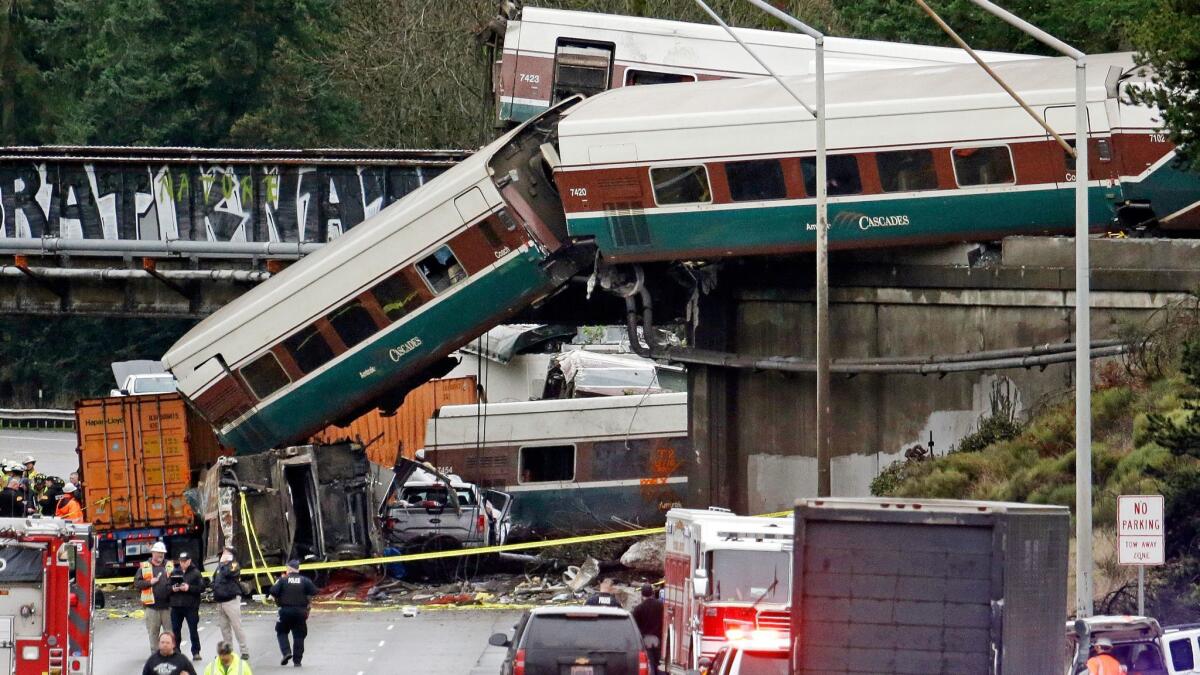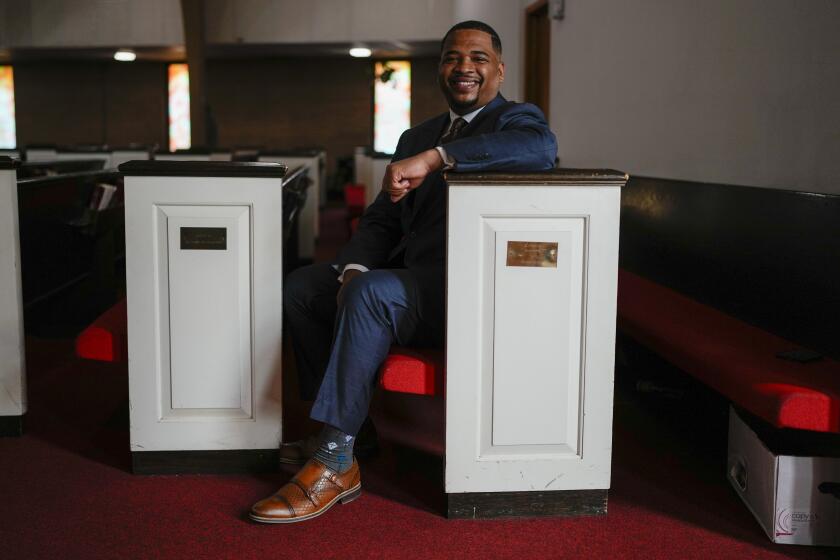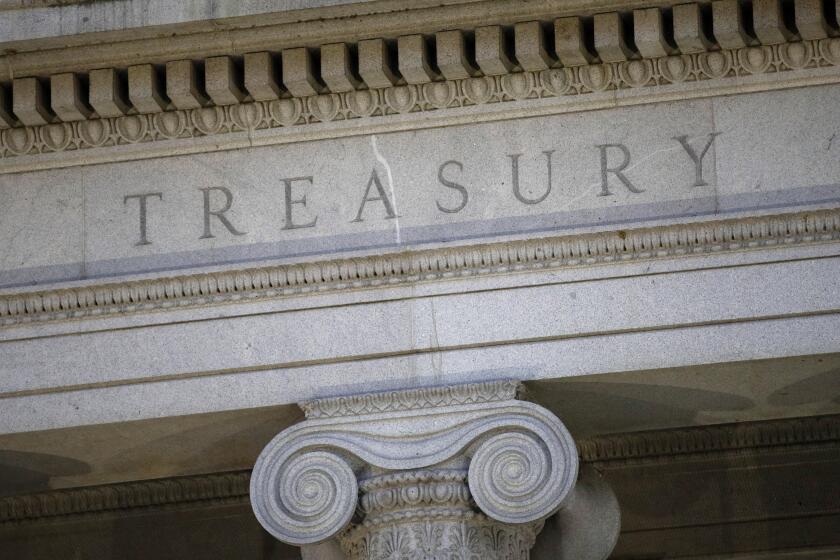Column: Will Trump’s infrastructure plan be another case of all talk, no action?

The policy catchword newly making its way around Washington this week is “infrastructure.”
You’ve heard the pitch: Infrastructure-building creates jobs! Everyone knows it’s sorely needed! It’s bipartisan!
Sure enough, President Trump has telegraphed that he’ll be rolling out an infrastructure plan in the next week, well in advance of his state of the union address Jan. 30. Capital pundits say this is wise, because infrastructure is almost the only policy proposal that doesn’t elicit instant political pushback. Given a choice among grappling with immigration and the Deferred Action for Childhood Arrivals program, dealing with the federal debt ceiling and other short-term budget concerns, or refurbishing our roads and bridges, who wouldn’t choose the last?
The environment around infrastructure will be more challenging.
— Adie Tomer, Brookings Institution
Unquestionably the U.S. has mortgaged its future by failing to keep up with infrastructure needs. Public construction spending as a share of gross national product has fallen to nearly its lowest level this century — and it wasn’t sufficient even at its peak.
But that only points to the question of why nothing has been done about infrastructure. One reason is that budget hawks opposed debt-financed investments in the future, which wasted more than a decade of rock-bottom interest rates on government debt.
Another reason is inattention. Republicans in Congress were preoccupied all year with trying to repeal the Affordable Care Act, then by passing a tax cut for the wealthy.
Trump spent nearly a year in office before even talking about an infrastructure plan. Now he’s suggesting that his new plan be passed without delay. (He even used the Dec. 18 fatal derailment of an Amtrak train in Washington state as a talking point.) The initial word from the White House is that next week’s release will encompass a set of general principles, rather than a detailed program. The plan will call for $200 billion in federal spending to be supplemented by $800 billion in state, local and private sector funding.
It’s unclear where states and localities are supposed to find their share of the funds, or whether the scheme will adequately provide for projects of more than state or local significance such as airports and interstate highways.
Indeed, the one ostensible policy success of the Trump White House — the big tax cut enacted last month — will work at cross-purposes with infrastructure funding.
“The environment around infrastructure will be more challenging,” says Adie Tomer, a Brookings Institution fellow who is familiar with some elements of the new plan. That’s because portions of the plan depend on heavier funding by states and localities — but the tax measure sharply cuts back the federal deduction for those taxes, making it harder to raise public money.
The scale of the tax cuts, which will cost more than $1 trillion over 10 years, also will mandate cuts in federal spending, some of which will affect existing infrastructure projects.
The only infrastructure proposal ever generated by the Trump camp was produced by Peter Navarro, a UC Irvine economist then advising the Trump campaign, and investor Wilbur Ross, now the Commerce Secretary.
But that document was less a plan to direct construction to where it was most needed so much as a proposal to give private parties an 82% tax credit on equity investments in government-subsidized projects. The effect would be to encourage more construction in areas where there’s already enough demand to justify private investment without a government handout — a squandering of the government’s share.
The proposal took a pitilessly free-market approach to infrastructure construction. As a campaign document, it attacked Hillary Clinton and the Obama administration for having “blocked or delayed billions of dollars of infrastructure projects through endless studies, government reviews, and litigation.”
That treated the regulatory regime over major construction as pure waste, rather than an attempt to weigh the interests of stakeholders who might not view a given project as an unalloyed boon — environmentalists concerned about the impact of the Keystone oil pipeline, for example. (The pipeline was blocked by the Obama administration over climate change and local environmental concerns, and it was reinstated by Trump.)
Navarro and Ross also had little use for the idea of infrastructure as a public responsibility. In their joint paper, Ross recalled noticing when he was New York Mayor Rudolph Giuliani’s privatization advisor, that the city’s water authority had a much worse record collecting unpaid bills from customers than its private electric, gas and phone utilities, because “customers knew that the private utilities would cut off their service if they were too delinquent, but a municipal authority would be far less likely to do so because of the political uproar that would result.”
Well, not exactly. The city had a responsibility to make sure its residents didn’t get sick or die from lack of water. The private firms didn’t feel the same imperative.
The Navarro-Ross plan soon fell out of favor, but the new proposal may share some of its devotion to the free market over the public interest.
According to the language Tomer saw, the proposal will have four parts. One is a call for reducing red tape, which could mean cutting back on environmental reviews and opportunities for local residents and other stakeholders to be heard.
The plan also calls for direct federal investment in “rural” projects, though it’s unclear how those projects will be defined. Another category is large-scale “transformative” projects. Their definition also is murky, but the Trump administration just bailed out on one project that might qualify. That’s the multi-billion-dollar Gateway tunnel for Amtrak trains, connecting New Jersey to Manhattan’s Pennsylvania Station on perhaps the nation’s most heavily traveled rail passenger route. The White House on Dec. 29 pulled out of plans to underwrite half the cost with loans, which may kill the project.
The fourth section involves competitive grants to state and local infrastructure projects as incentives for them to raise the balance on their own, whether through tolls and user fees or taxes and municipal borrowings.
“The tax bill has made locally financed infrastructure more expensive,” Tomer told me, “and legislative experts say that the PAYGO rules will require budget offsets.” (PAYGO, or pay-as-you-go budget rules require that budget deficits be covered via spending cuts.)
One other wrinkle: Trump earlier talked of using tax revenues from corporate profits repatriated from abroad as infrastructure funding. The tax measure he signed fails to provide for that, meaning that it’s lost as a source of revenue.
That’s a hint that Trump’s advocacy of infrastructure spending is just talk. It’s certainly true that the country could spend $1 trillion on refurbishing its roads, bridge and airports, building more infrastructure where it’s needed and extending the effort to new-economy projects, such as broadband access.
But the $1 trillion that could have been spent on those projects has been spoken for by corporations and the 1%, who will pocket it as tax breaks. If Trump can turn out an infrastructure plan that is more than political theater, more power to him. As Tomer says, “We really need to wait until we see the actual pages.”
But the signs aren’t encouraging.
Keep up to date with Michael Hiltzik. Follow @hiltzikm on Twitter, see his Facebook page, or email michael.hiltzik@latimes.com.
Return to Michael Hiltzik’s blog.
More to Read
Start your day right
Sign up for Essential California for news, features and recommendations from the L.A. Times and beyond in your inbox six days a week.
You may occasionally receive promotional content from the Los Angeles Times.







